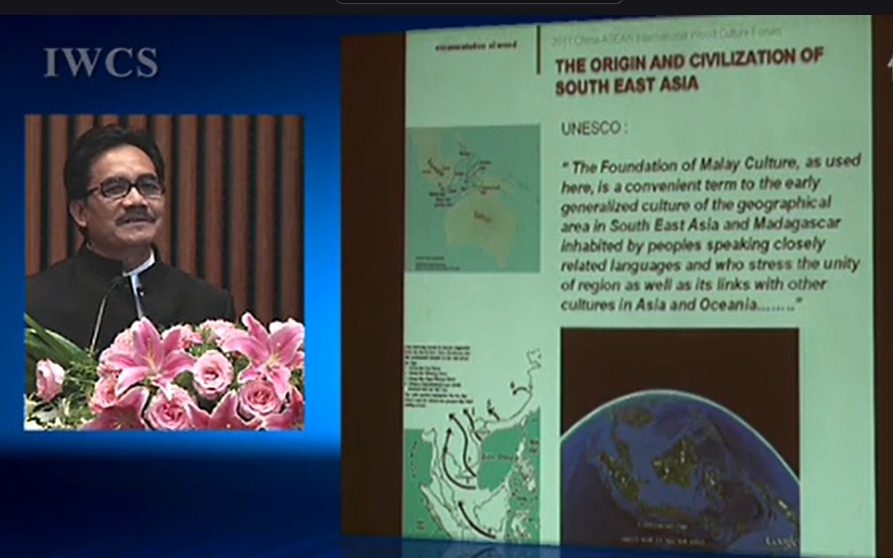会议名称:2011中国—东盟国际木文化论坛
会议时间:2011年11月18日
会议地点:南宁国际会展中心
演讲嘉宾:Mastor Surat 马来西亚国民大学高级学术研究员
报告摘要:Wood is an organic material which ‘architecture’ was almost certainly pioneered in wood. It provided mankind’s first built shelter and techniques of jointing timber were later translated into masonry and concrete. Ornamentation in building is something about beautification of building elements such as post and beam, wall paneling, roof structures, staircases etcetera. Those are about added values to the building’s appearance. The kind of people who built timber buildings and its ornamentation varied enormously from culture to culture. In the olden days, ornamentation was also a kind of conveying certain message in a syntax manner on addressing certain issues in relation to time, place and the owner of the building that also related to history. The practice of carpentry was awarded the greatest status in China, Japan as well as for Malay society.
In the Modern era, most of the modernist was rejected ornamentation in building especially for those which related to history. Wood was only used in building with the approach of minimalism or with the concept of ‘less is more’. The development of technically advanced materials found further support at the start of the twentieth century with the standard-bearers of the European Modern Movement in architecture: Gropius, Mies van der Rohe and Le Corbusier. These architects ultimately set the agenda for the rest of the century by proposing to build with an entirely ‘contemporary’ palette of steel, glass and concrete, more befitting the ‘spirit of the age’. However in the developing countries of the Tropics, where timber houses are still built in the traditional manner, these traditions have come under threat from the perceived advantages of ‘modern’ industrial materials. Throughout their long history, timber buildings have been separated from the rest of architecture for failing to have the same attributes as masonry buildings.
However the follower of post-modernist claimed that the modernist has destroyed history and the craftsmanship works who also criticized their works as ‘silent and dead’. Therefore they encourage using back ornamentation and the value of history in building. However during those times they found that most of craftsmanship works has discontinued and had lost on the momentum of skills and the philosophy of the works. Ornamentation was produced in very simplistic manner with the approach of imitation, reviving and eclectic rather than developing the ideas. In the current approach of development with the global force on ‘green issues’ wood is back as organic material but only been used as part of decoration elements rather than the main building components. It was because of due to demands of the developments especially to large building which governed by the requirements of safety. However to certain countries like US, Australia and Scandinavia, wood as super structures are widely used with very contemporary technologies such as glue-laminated beams, portal frames and lamella frames etcetera. Ornamentation of wood has no longer conveying message of the owner but of the technology which part of ‘the spirit of time’. The focus of this presentation is on the development of ornamentation of wood in building of South East Asia and how it communicates with the people from the past to present.
嘉宾简介:Mr. Mastor Surat, a Senior Academic Fellow at Department of Architecture, Faculty of Engineering and Built Environment, The National University of Malaysia (UKM) since 2004. He is also a Senior Research Fellow at Solar Energy Research Institute (SERI), UKM and at Malay World & Civilisation Institute (ATMA), UKM, since 2006. He was the Head of Department for Architectural Department, Faculty of Engineering and Built Environment,UKM from May 11, 2008 to May 11, 2011. Mastor has possesses vast experience and exposure to professional consultancy and architectural practices as well as academic experience who is currently a Director for UKM Perunding Kejuruteraan & Arkitek Sdn. Bhd. (multi-discipline consultancy practice) since 2006 to present. Mastor is the founder of MASTOR ARCHITECT, a sole proprietorship practice which was established in 02.02.2002
In 2004, Mastor won Bronze Medal during UKM Creative & Innovative Exhibition for his work on traditional Malay heritage architecture. In 2006, he won Honourable Mention PAM Award 2006 For Excellence In Architecture under category Public & Civic Building for Boh Visitor Centre, Cameron Highland project and won Mention PAM Award 2006 For Excellence In Architecture under category Overseas Projects for Zhongtai Beijing Office & Showroom project in 2007, Mastor has awarded Excellence in Service by UKM in 2007.


 16,153
16,153